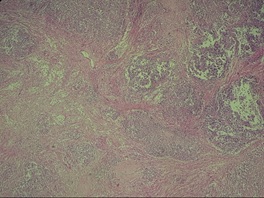Desmoplastic Infantile Astrocytoma and Desmoplastic Infantile Ganglioglioma – not so infantile anymore
Abstract
DIA and DIG are rare, infantile, supratentorial neoplasms that usually occur in children before 2 years of age and are exceedingly rare in older age groups. They appear as hypodense, cystic masses with solid components showing dural attachment on neuroimaging. They are characterized by reticulin-rich spindle cell stroma containing connective tissue due to meningeal involvement, microscopically. These tumors have potential for misdiagnosis because they contain varying proportions of neoplastic glial, neuronal and poorly differentiated cells, which causes them to have a “small round blue cell tumor” like appearance, though they have a good prognosis if correctly diagnosed. The current study report two cases diagnosed at our institution that had very late presentation with varying complaints which challenged the normally believed dictum of these tumors being entirely infantile.
Downloads
References
Vandenberg SR. Desmoplastic infantile ganglioglioma and desmoplastic cerebral astrocytoma of infancy. Brain Pathol 1993; 3(3):275-81. doi: 10.1111/j.1750-3639.1993.tb00754.x.
Brat D, VandenBerg S, Figarella-Branger D, Reuss D. Desmoplastic infantile astrocytoma and ganglioglioma. In: Louis DN, Ohgaki H, Wiestler OD, et al., editors. WHO Classification of Tumours of the Central Nervous System. Lyon: IARC; 2016, pp 144–146.3.
Louis DN, Ohgaki H, Wiestler OD, Cavenee WK, Figarella-Branger D, Reifenberger G, et al. WHO classification of tumours of the central nervous system. Lyon, France: World Health Organization; 2016.
Naylor RM, Wohl A, Raghunathan A, Eckel LJ, Keating GF, Daniels DJ. Novel suprasellar location of desmoplastic infantile astrocytoma and ganglioglioma: a single institution’s experience. J Neurosurg: Pediatr. 2018;22(4):397-403. doi: 10.3171/2018.4.PEDS17638.
Taratuto AL, Vandenberg SR, Rorke LB. Desmoplastic infantile astrocytoma and ganglioglioma. In: Kleihues P, Cavenee WK, editors. WHO Classification of Tumors, Pathology and Genetics: Tumors of the Nervous System. Lyon: IARC; 2000. pp. 99–102.
Brat D, VandenBerg S, Figarella-Branger D, Taratuto A. Desmoplastic infantile astrocytoma and ganglioglioma. In: Louis D, Ohgaki H, Wiestler O, Cavenee W, editors. WHO Classification of Tumours of the Central Nervous System. Lyon: IARC; 2007. pp. 96–98.
Gelabert-Gonzalez M, Serramito-García R, Arcos-Algaba A. Desmoplastic infantile and non-infantile ganglioglioma. Review of the literature. Neurosurg Rev. 2011;34(2):151-158. doi: 10.1007/s10143-010-0303-4.
Greer A, Foreman NK, Donson A, Davies KD, Kleinschmidt‐DeMasters BK. Desmoplastic infantile astrocytoma/ganglioglioma with rare BRAF V600D mutation. Pediatr Blood Cancer. 2017;64(6):e26350. doi: 10.1002/pbc.26350.
Samkari A, Alzahrani F, Almehdar A, Algahtani H. Desmoplastic infantile astrocytoma and ganglioglioma: case report and review of the literature. Clin Neuropathol. 2017;36(1):31. doi: 10.5414/NP300945.

Copyright (c) 2020 Author (s). Published by Siddharth Health Research and Social Welfare Society

This work is licensed under a Creative Commons Attribution 4.0 International License.


 OAI - Open Archives Initiative
OAI - Open Archives Initiative


